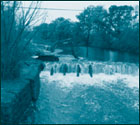
In Wisconsin, some individuals and organizations aren’t just talking about removing dams. They are getting rid of them. A number of factors- the desire for free-flowing rivers, the high costs of maintaining old dams, and the dangers posed by aging dams-are behind the removals. In addition, these individuals and groups are documenting the biological effects of dismantling a dam.
At the heart of this project is the Sand County Foundation, a nonprofit organization based in Madison, Wisconsin, which manages the property on which Aldo Leopold wrote A Sand County Almanac. The foundation’s goal is to follow in Leopold’s footsteps by promoting “ethical and scientifically sound land management” (Sand County Foundation 2003). Rehabilitating Wisconsin’s flood plains is part of that management, which can mean the removal of old levees and aging dams to restore the flow of rivers and recreate more traditional riparian habitat.
Wisconsin has close to 4,000 dams, mostly private constructions, many very old. They were built to power grain mills or saw mills, to transport logs from logging sites, and to provide hydropower. Most of these dams are small-they create a reservoir with a water volume of less than 100 acre-feet (an acre-foot is the amount of water that covers an acre one foot deep, or 43,560 cubic feet). These dams are now obsolete. They no longer provide economic gains for the owner, fail to meet current safety standards, and are deteriorating.
According to Wisconsin law, any dam structure abandoned by the owner and too costly to maintain can be removed by the state’s Department of Natural Resources, at taxpayers’ expense. The state has taken down more than 100 dams in the past three decades. But the number of eligible dams exceeds the state’s ability to dismantle them quickly, and many private owners face high costs of repair for dams that are no longer of economic value.
So private organizations such as Sand County have stepped in to contribute funds and move the process along. “Typically, dam removal costs less than $40,000, and it is a one-time cost,” says Brent Haglund,1 president of Sand County. Working with the state, the River Alliance of Wisconsin, the National Fish and Wildlife Foundation, and the U.S. Fish and Wildlife Service, Sand County helped remove four dams from the Baraboo River between 1997 and 2001, liberating nearly 120 miles of water.
With each dam removal, says Brent Haglund, “not only is that stretch of river able to flow freely, but so are hundreds of miles of streams that supply that portion of the river.” The Baraboo removals also yielded “cleaner water, additional recreational activity, and increased economic development.” Haglund cites the towns of Baraboo, Reedsburg, and LaValle as beneficiaries.
Although returning a river to a more natural state is a high priority, safety is the leading reason. An unsafe dam “is likely to burst with a thunderstorm,” says Haglund. In July 2001, two people drowned in the undertow around the Baraboo’s Glenville Dam, which did not have protective features or adequate warning -its removal came two and a half months too late. Sand County strives to prevent such catastrophes.
But dismantling a dam has an environmental impact, just as initial construction of the dam did. Removal “disrupts and reconfigures the existing physical environment and eliminates an entire ecosystem,” report Martin Doyle and Emily Stanley, ecologists who investigate dam removals. Removing a dam is “not a gentle process,” they say (Doyle and Stanley 2003, 20).
The biggest impact comes from the sediment that has accumulated behind the dam. Dismantling must be careful or too much sediment may be released, damaging downstream wildlife such as freshwater mussels. One option is to transport sediment to a designated area away from the river, although this is costly.
Not all communities welcome dam removal. Frequently, residents adjacent to a dam feel that it is “a part of the landscape,” or a “symbol of man’s triumph over nature” (Grossman 2002, 145, 13). “Dam busters” must acknowledge this perspective and provide incentives for residents to embrace the removal, as Sand County did when it bought the LaValle Mill and Dam, a dam built to power a grain mill. Sand County “relieved the previous owner of several hundred thousand dollars in repairs,” says John Laub2, Sand County’s river program manager. The organization then sold the mill structure “at a very affordable price to a local farming couple.” It is now an antique business.
One dam at a time, the people of Wisconsin are changing their landscape. The success of these dam removals may well have an impact on future decisions about bigger dams around the country. And meanwhile, these removals are saving wildlife habitat, and perhaps human lives as well.
NOTES
1. Brent Haglund, president, Sand County Foundation, telephone interview and e-mail correspondence, June 16, 2003.
2. John Laub, river program manager, Sand County Foundation, e-mail correspondence, July 7, 2003.
REFERENCES
Doyle, Martin, and Emily Stanley. 2003. Trading Off: The Ecological Effects of Dam Removal. Frontiers in Ecology and the Environment. 1(1): 15Ð22.
Grossman, Elizabeth. 2002. Watershed: The Undamming of America. New York: Counterpoint.
Sand County Foundation. 2003. Our Mission. Online: www.sandcounty.net/hands_on.asp (cited June 16, 2003).


